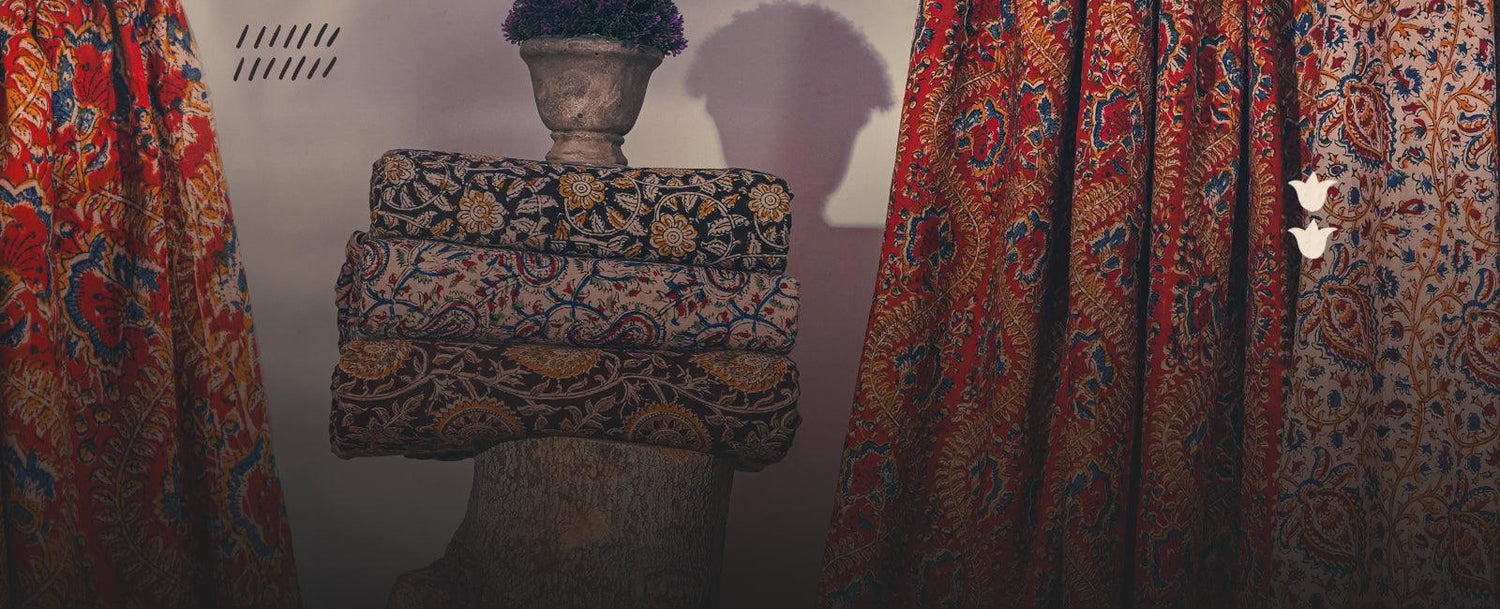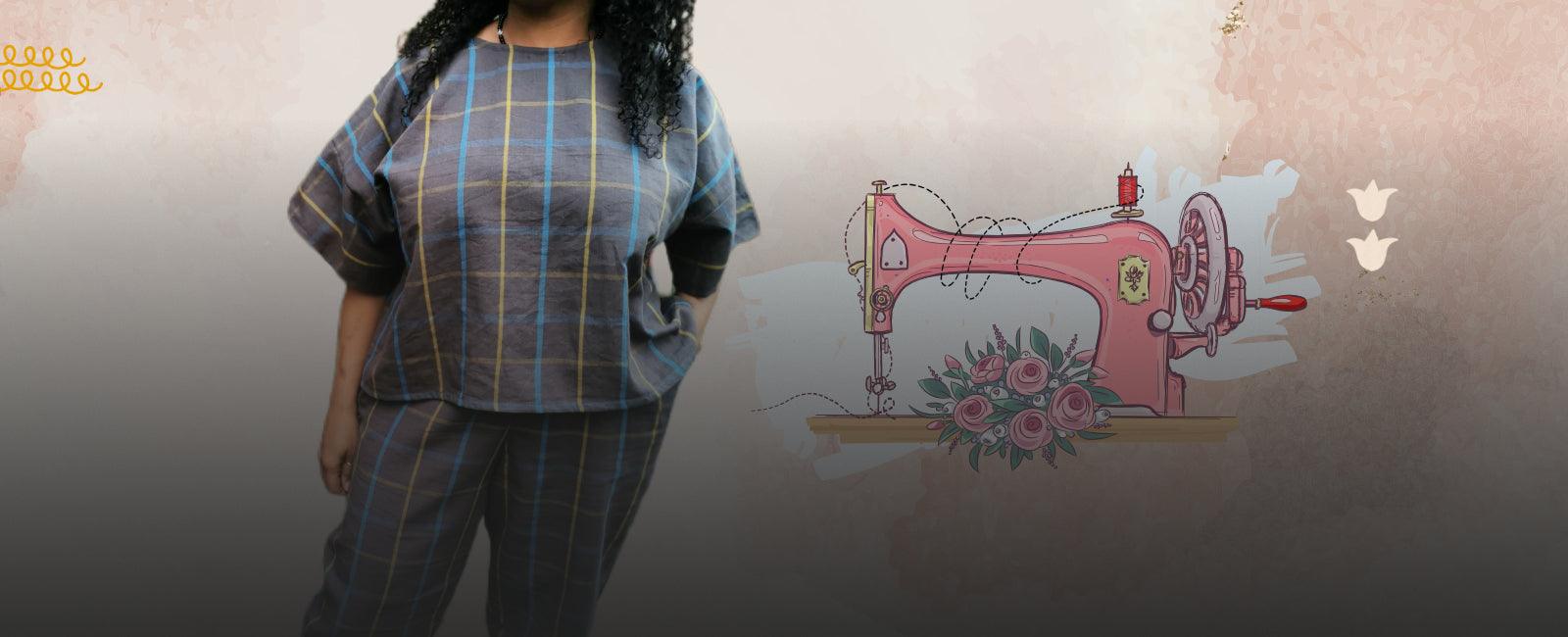There's much to learn from Traditional Indian Chitrakars, but if there's one that is deemed as a must - it would be the Kalamkari technique.
Kalamkari Fabric is hand-painted or block-printed fabric. The name itself is derived from the Sanskrit word "Kalam" which means Pen, and the technique employs a similar pen for free-hand drawing on top of a Kalamkari material.
This particular process was otherwise called Srikalahasthi, which is one among two important styles of Kalamkari. However, before we delve deeper into those, it is important to understand the origin and the historical significance of Kalamkari.
Origin
Though many historians believe the origin of Kalamkari to be shared between India and Iran, the technique was predominantly practiced in the Southern state of Andhra Pradesh. At that time the technique also served a profound significance of depicting the stories of Hindu Mythology to village dwellers. Traditionally Kalamkari print fabric is practiced in two different styles - the Srikalahasti style and the Machilipatnam style.

As discussed before Srikalahasti style is akin to free-hand drawing. Machilipatnam, however, is similar but employs Vegetable dyes and wooden blocks to create eye-catching designs. With the technique taking off in recent times, there are a lot of artists trying out Kalamkari. Which makes it harder to spot the original from knock-offs. Authentic Kalamkari is a rarity and you need careful eyes to spot one
Authentic Kalamkari
Believe it or not, irregularities in your dye work serve as a solid clue to see if you are wearing an authentic kalamkari fabric. This is because Handblock Kalamkari can never be perfect. Whereas digitally printed designs would look flawless. Authentic Kalamkari is often made using wooden hand-blocks and is completely done manually.


Most often you'll find cotton fabric used, but there are artists employing silk as well. Nonetheless, it is the Kalamkari Cotton Fabric that piques interest within the community for the comfort and easy-to-carry(especially for sarees) properties.
Handblock Kalamkari
While we discussed the rarity and scope of counterfeits for Handblock Kalamkari in the market, we haven't quite discussed why this is rare. First things first, the production of Handblock Kalamkari is strenuous and time taking. That is the reason why a majority of the artists have migrated from this technique.
Secondly, the process employs natural bleaching. Though it is eco-friendly, it takes 3 days to complete - and not everyone would be happy with this timeframe. Finally, the cost of a machine-made Kalamkari is much lower than the authentic one. The seven-step process influences the cost factor the most. To know why here are the seven steps:
- Bleaching - Time taken is 3 days, all-natural.
- Removing impurities using Myrobalan treatment. This forms the cleansing part of the process
- Block printing - colors are imposed through the use of wooden blocks.
- The fabric is thoroughly washed
- After washing the fabric is immersed in a pot of boiling water.
- The second coating of paint is done through a Wooden block. This time, the patterns start to take shape.
- Wash and Dry before Dispatch!

Outfit Ideas
Kalamkari is unique and blends well with almost all ethnic outfits. Though we are yet to see a surge in Kalamkari material for formal wear, people tend to experiment and mix it with a kalamkari silk fabric dupatta. That being said, here are a few outfit ideas for making the most out of your Kalamkari fabric!

Sharara
Sharara is an epitome that ethnic wear can be both elegant and at the same time comfortable. If you're bored of a plain sharara set, you can revamp your wardrobe with a Kalamkari inspired Sharara. The best thing is the entire outfit's simplicity - the end product won't be as embellished but royal enough to make you stand out in functions.
Lehengas
Similar to Shararas, Lehengas never go outdated in ethnic fashion. While classic digitally printed Lehengas do work to some extent, to truly bring out the traditional roots of a Lehenga, hand-block printing is necessary. Srikalahasthi Lehengas are very popular and when worn with Satin Net and Belt across the dress made of kalamkari dress material, you will feel as if you are a part of a royal movement!
Saree
Boost the aesthetics of your bridal wear by carrying a Kalamkari Silk Saree. You can start from a Kancheepuram Silk Saree and paint it artistically with Kalamkari elements in a way that the colors get along well and when put together looks stunning but not gaudy!

Palazzo
Can't call this a mainstream hit, Kalamkari inspired Palazzo is still in the experimentation phase. This idea was inspired by the Sharara, but to extend it to formal and casual wear. The wide-legged trousers will give enough area to flaunt the free-hand drawing, but matching it with a formal dress would require a creative mind.

Kaftan Top
Don't think all is lost, we do have one suggestion for you on how to match Kalamkari Palazzo. Kaftan Top is trending nowadays, and if you can find the right hand-block printed top, it will go well with the Palazzo. The tricky part is infusing colors to the top and keeping the bottom less embellished to make the product look simple, not gaudy.
Some more options for you to take inspiration for your Kalamkari outfit:


There's much to do with Kalamkari, but with the recent boom in ethnic fashion, it only makes sense that this technique is rigorously used in traditional wear. However, If you feel like experimenting you can check out the Kalamkari fabric collection online on our inventory.
Choose the best one for your project and flaunt this ancient wear to your next ethnic outing.




